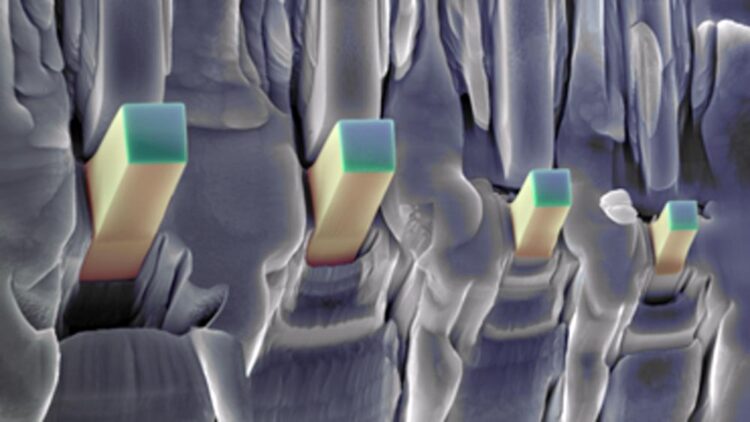Smallest earthquakes ever detected in micron-scale metals

On the micrometer scale deformation properties of metals change profoundly: the smooth and continuous behaviour of bulk materials often becomes jerky due to random strain bursts of various sizes.
Credit: Péter Dusán Ispánovity and Dávid Ugi
On the micrometer scale deformation properties of metals change profoundly: the smooth and continuous behaviour of bulk materials often becomes jerky due to random strain bursts of various sizes.
On the micrometer scale deformation properties of metals change profoundly: the smooth and continuous behaviour of bulk materials often becomes jerky due to random strain bursts of various sizes. The reason for this phenomenon is the complex intermittent redistribution of lattice dislocations (which are line-like ctystal defects responsible for the irreversible deformation of crystalline materials) due to external loading, which is also the cause of the formation of the uneven step-like surface upon deformation.
To study this phenomenon in more detail, research groups of the Eötvös Loránd University of Budapest, Charles University of Prague and École des Mines de Saint-Étienne have developed a highly sensitive micromechanical platform, where weak elastic waves emitted by the specimen can be detected during the deformation of micron-scale pillars. Compression experiments performed on such zinc single crystalline micropillars in a scanning electron microscope confirmed that these so-called acoustic signals indeed occur during strain bursts, so, this experiment allowed us, for the first time, to practically hear the `sound of dislocations’.
The acoustic signals are sampled with a rate of 2.5 MHz, therefore, they provide extremely detailed information on the dynamics of dislocations. The in-depth statistical analyses performed by the researchers revealed that strain bursts exhibit a two-level structure: what has so far been seen as a single plastic slip is, in fact, a result of several correlated events on a μs-ms timescale.
The most surprising outcome of the experiments is that this process,
despite the fundamental differences between deformation mechanisms of metals and that of tectonic plates, was found to be completely analogous to earthquakes.
Acoustic signals emitted from the testpieces followed fundamental empirical laws established for main shocks and aftershocks in seismology, such as the Gutenberg-Richter and Omori laws.
| VIDEOABSTRACT: https://youtu.be/kAf4iP8PnkUCompression of a zinc micropillar. The otherwise ultrasonic acoustic signals were transformed into the audible domain to better illustrate the correlation between acoustic events and strain bursts. |
`These results are expected to bear high technological impact since, for the first time, we were able to observe direct connection between acoustic signals and the plastic events that emitted them’ said Péter Dusán Ispánovity, assistant professor at Eövös Loránd University and head of the Micromechanics and Multiscale Modelling Research Group. `Since the measurement of acoustic emission is a frequent method for monitoring and locating material failure in technological applications, by providing fundamentally new information about the underlying physics our results are expected to contribure to the further development of this technique.’
Dávid Ugi, PhD student in the group of Ispánovity and corresponding author of the publication added: `These experiments are rather complex, since one has to couple the nanometer precision manipulation tool with the extremely sensitive acoustic sensor, all in the vacuum chamber of a scanning electron microscope.
Such measurements, to our knowledge, at the moment can only be performed at our laboratory’ added the young researcher.
The methodology can also be used to investigate other types of deformation mechanisms, such as twinning or fracture, so the results, which were published in Nature Communications, are expected to open up new vistas in the research of micromechanical propeties of materials.
Journal: Nature Communications
DOI: 10.1038/s41467-022-29044-7
Article Title: Dislocation avalanches are like earthquakes on the micron scale
Article Publication Date: 13-Apr-2022
Media Contact
Sara Bohm
Eötvös Loránd University (ELTE), Faculty of Science
sara.bohm@ttk.elte.hu
Office: 36-205-210-454
Original Source
All latest news from the category: Earth Sciences
Earth Sciences (also referred to as Geosciences), which deals with basic issues surrounding our planet, plays a vital role in the area of energy and raw materials supply.
Earth Sciences comprises subjects such as geology, geography, geological informatics, paleontology, mineralogy, petrography, crystallography, geophysics, geodesy, glaciology, cartography, photogrammetry, meteorology and seismology, early-warning systems, earthquake research and polar research.
Newest articles

Innovative 3D printed scaffolds offer new hope for bone healing
Researchers at the Institute for Bioengineering of Catalonia have developed novel 3D printed PLA-CaP scaffolds that promote blood vessel formation, ensuring better healing and regeneration of bone tissue. Bone is…

The surprising role of gut infection in Alzheimer’s disease
ASU- and Banner Alzheimer’s Institute-led study implicates link between a common virus and the disease, which travels from the gut to the brain and may be a target for antiviral…

Molecular gardening: New enzymes discovered for protein modification pruning
How deubiquitinases USP53 and USP54 cleave long polyubiquitin chains and how the former is linked to liver disease in children. Deubiquitinases (DUBs) are enzymes used by cells to trim protein…



